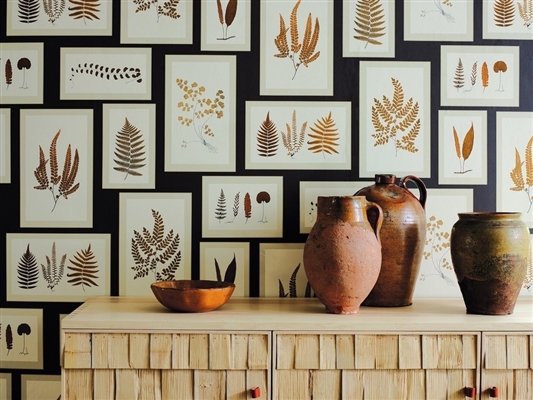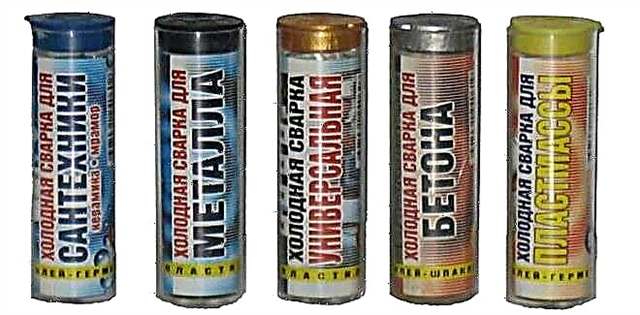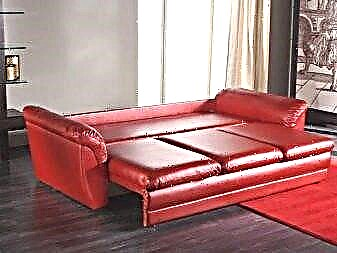Tulle - in modern everyday life, under the general name of curtains on windows, various types of fabrics are hidden. As a material, tulle is a thin transparent fabric, smooth or with embroidery, pattern, plain or color.
Acting as a partner for curtains, tulle helps create a unified interior composition
Varieties of tulle by type of fabric
The rich variety and types of tulle curtains can be represented by the following samples:
- Organza. It is a transparent, shiny fabric made of cotton, viscose, polyester or silk. It is easy to clean and perfect for poorly lit rooms. It is a strong and durable material. The disadvantage is rigidity and a tendency to crease.
Organza holds folds well and is therefore ideal for creating lush assemblies.
Kisei is often used not only for window decoration, but also for zoning a room
A mixed fabric veil keeps drapes great
The grid can have cells of different geometric shapes - a cell, a rhombus, honeycombs, or a spider web, as in the photo
Linen weaving makes muslin durable and low density soft and supple
The color scheme of tulle is very diverse. Today, the fashion trend is pink, turquoise, lilac, green, yellow. Very often, along with plain shades, a combination of several colors is found. For example, a light color that fades into dark. If you do not know which tulle to choose and which color is suitable, then choose fabrics with a shade that varies depending on the angle of view.
Note! Psychologists have found that too bright and flashy colors of red or orange are not suitable for the bedroom. It is better to prefer them for the hall or kitchen, as they are characterized by a tonic effect and may interfere with sleep.
It is important that the red tulle resonates with the decor, it can be a sculpture or carpet
Orange tulle adds warmth to the room and makes the window stand out against the background
Criteria for choosing tulle to wallpaper: a combination of color, style, window design
When choosing tulle in the room, it is necessary to proceed from what wallpaper is pasted in the room. Indeed, exposure in style and color is the key to a harmonious interior, and this should not be neglected.
The colors of the walls and curtains should not be the same, otherwise they will merge together with visual perception
Curtains, closely repeating the color of the wallpaper, visually expand the room
Contrast curtains make the room visually smaller
Here are the main recommendations on how to choose the right tulle for wallpaper:
- The shade of the curtain should be either a couple of shades darker than the wallpaper, or contrasting. The perfect combination is bright and rich wallpaper with pastel tulle colors.
- Different types of tulle on the windows will look harmonious in the interior depending on the lighting. If the room is dark, it should be brighter, add more delicate shades, for example, pick up curtains from an air organza or veil. If the room is on the sunny side, you should choose a dense product that does not allow sunlight, such as muslin.
- In order for the window to stand out favorably in the room, you need to choose a simple, plain curtain to the patterned wallpaper. If there is embroidery, ornament or monogram on tulle, then it is ideal for plain wallpaper.
- To visually expand the space of a room, you should pay attention to cold colors, if the goal is to reduce the room, then to warm.
- If the window is located in a niche or has a horizontal view, then the curtain must be hung up to the level of the window sill.
When decorating the window with different curtains, one of them should repeat the color of the walls
In modern design it is fashionable to use contrasting shades
Please note! If in a year or two you are going to make repairs and change the wallpaper, then the appearance of the curtains is better not to be tied to wallpaper. Find other criteria to choose: type of curtain fabric, room style.
Bright curtains will decorate a room with plain wallpaper
Gray or silver curtains blend perfectly with blue wallpapers.
Criteria for the selection of tulle to curtains: a combination of color and tone, the distance between the curtain and tulle
Properly selected curtains can unrecognizably change the apartment. Try to choose a tulle to the curtains harmoniously, guided by the rules.
Before choosing curtains and tulle, you need to decide what will be the background and what you will put as an accent
How to choose a tulle taking into account curtains - selection rules:
- When choosing a kit from curtains and curtains, follow the rule: one of the elements should be combined with the wallpaper, and the other should complement or contrast the accent.
- When choosing materials for curtains and curtains, give preference to fabrics in the same tone and in different shades or contrasting. For a bedroom, for example, a combination of burgundy and pink will look beautiful.
- Do not avoid experiments: it may sound funny - a tulle curtain in a flower, for example, a tulip, and vintage brown striped curtains - but in reality it can look extremely cute and beautiful.
- Pay attention to the material. So, a dense, slightly rough crepe is ideal for tulle made of smooth organza.
If there are patterns on the curtains, the tulle should repeat them, or remain neutral
A flower tulle looks cute on the windows of a bedroom, both in rustic and modern styles
If you are interested in the distance between the tulle and the curtain, then this parameter is determined even at the stage of installation of the cornice. If it is too small, then it will be impossible to collect beautiful folds.
The distance between the tulle and the curtain depends on the size of the folds on both curtains.
Varieties of tulle in size, tone and quality of fabric
Having wondered what a tulle is, many housewives are lost, because there are many varieties of it. It can be a plain plain tulle 240 cm high for a bedroom or a short tulle 150 by 150 cm for a kitchen room or a gazebo in the summer.
When choosing a tulle for the kitchen, pay attention to the fact that the material is impregnated with a special antistatic and dirt-repellent composition
If you want to sew the curtain with your own hands, then it is best to buy tulle fabric with a meter. In this case, you will have a lot of room for imagination and design scope. In addition, a wholesale purchase will be cheaper.
For individual tailoring, you should take into account the characteristics of the fabric, first of all - its shrinkage after washing
How to choose a tulle to the style of different rooms
Choosing curtains in different rooms is not an easy task, because shops can offer many options for a creative approach. Much depends on the goals you want to achieve.
- If the room is too light, sunny, then do not buy organza or mesh - they will let in light.
- And vice versa, if the view from the window is very beautiful and you want to emphasize it and extend the perspective, it is best to choose a transparent fabric.
- For a bedroom, dense printed material is often chosen, sometimes colored.
- And for the kitchen, the best choice is the short tulle in the room.
- For the hall you need a beautiful, presentable fabric: organza, muslin, veil, smooth or with a pattern, lace inserts.
Tulle should harmoniously fit into the overall style of the room. For example, for minimalism, transparent straight-line canvases are suitable.
For baroque or other style of the classic direction, lush and dense fabrics are suitable
Hi-tech is characterized by light air curtains, options with unobtrusive geometric patterns are acceptable
The combination of tulle with a Roman curtain is appropriate in a modern living room, nursery or bedroom
When deciding how to choose the right tulle, several parameters should be taken into account: the size and type of premises, the season, the color of wallpaper and curtains, the style direction of design, your own desires. When buying curtains for windows, be guided not only by taste, but also by the advice of specialists. As a last resort, look on the Internet for descriptions and photos of beautiful tulles and color combinations in the interior. They can set an example for inspiration, flight of imagination and creativity.
How to choose the right type of tulle in the room?
The characteristics of this translucent material are largely dependent on the fibers of which it is made - natural or synthetic. Most often for this purpose they use:
- cotton - natural fibers, which are characterized by environmental friendliness, hypoallergenicity, breathability,
- silk - threads obtained from silkworm cocoons, expensive, are used for the manufacture of status panels,
- polyester - synthetic fiber, inexpensive, durable and practical.
Most often in the production of modern fabrics using blended fibers that combine natural and synthetic yarns. Thanks to their use, fabrics are obtained that combine the advantages of natural and synthetic materials.
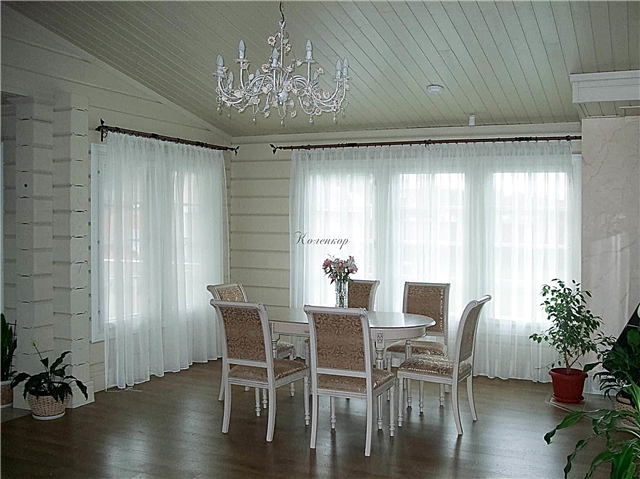
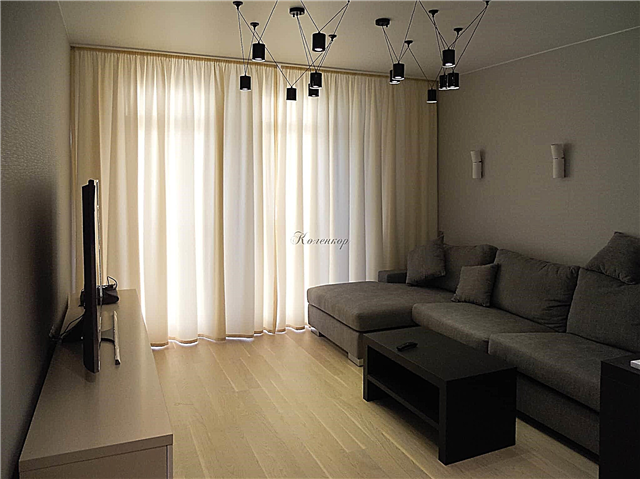
Do you like the curtains? You can order the same in the Living Room section
Tulle is a family of mesh fabrics that vary in weave structure. It includes the following fabrics:
- Veil. Translucent material, suitable for rooms in a romantic style, due to the creation of the effect of "haze". It is better to wash such a delicate fabric by hand.
- Lace-like patterns. Used for sewing curtains in living rooms and halls.
- Grid with large, visible cells, similar to honeycombs. It has good light and breathability. The disadvantage of this fabric is the accumulation of dust, so it is not recommended for use in rooms in which allergy sufferers live.
- Kisei - material of special openwork weaving, in which the threads are fastened only from above. It is made mainly from natural fibers.
- Muslin. Dense and practical fabric made from synthetic yarns. Minus - poor breathability.
- Organza - gloss material, the production of which is usually used mixed fibers. Beautiful, transparent, it is perfect for poorly lit rooms. The material is durable, practical, pretty tough.
- Reaper - fabric with stable effective creases.
The classic version is white tulle. But more often they use brighter fabrics with various decorative elements. The material can be decorated with print, embroidery, sequins. Decor options for tulle curtains - brushes, fringe, ruffles.


Do you like the curtains? You can order the same in the Bedroom section.
Such a variety of types of weaving and additional decor allows you to choose the appropriate option for rooms of various functionalities, sizes and architectural features.
How to choose the color of tulle?
When choosing air material that will be used as an independent element of window decoration, two options are possible:
- The combination of the color of the curtain with the color of wallpaper, furniture, interior textiles. It is desirable that the curtain is one or two tones darker or lighter than the wallpaper.
- The contrast of the color scheme of tulle with the color of the interior. White or light beige tulle looks beautiful in combination with dark furniture or dark / bright blackout curtains. White airy fabric is combined with all colors, perfectly refreshes the space. The only significant drawback is the rapid pollution. Pastel-colored tulle curtains go well with brightly colored wallpaper.
When deciding what color to choose tulle, it is also advisable to consider the following recommendations:
- For rooms with windows facing the sunny side, you can choose material in cold shades - blue, gray, silver - that will refresh the room and create a feeling of coolness. Cold shades visually expand the space. A dense muslin is suitable for the sunny side.
- For windows facing north and west, curtains with high light transmission and in warm colors are used. It is peach, golden, shades of yellow, orange, pink.
- In low rooms, vertical print curtains are appropriate. For this purpose, panels with lurex lines or a combination of monophonic strips - matte and shiny are suitable.
- Visually expand narrow windows help models with horizontal stripes.
The modern version is fabrics with the ombre effect (gradient), in which the light shade smoothly turns into dark. If you find it difficult to figure out how to choose the color of the tulle, buy a material in which the shades vary depending on the angle of view.
Attention! Fabrics that are too bright shades of red and orange are not suitable for the bedroom, but are quite appropriate in the kitchen.
If tulle is used independently, then unique compositions are created using complex draperies. The combination of two tulle segments of different colors, harmonizing with each other or contrasting, looks spectacular. Stripes are intertwined with each other, layered, assembled with ribbons or hairpins.
How to choose a beautiful tulle for blackout curtains?
This translucent fabric for window decoration can be used either alone or in combination with a denser material. What options are successfully combined with tulle:
- Jacquard - a material with a woven pattern.
- Blackout - opaque canvas with a variety of colors. They can be plain and with a pattern, light and dark.
- Velvet - the same, with a fleecy surface.
- Satin and satin - canvas with a glossy surface.
- Brocade - heavy, elegant, with embroidery with golden and silver threads.
- Cotton and linen - used in eco and country style rooms.
Which tulle is better to choose considering the blackout curtains:
- When selecting a kit, it is desirable that one of the fabrics is combined with the color of the wallpaper. The companion must match her tone or contrast.
- Options look beautifully designed in one color or differing by one or two tones. One companion is monophonic, the second with a pattern that differs from the base in color or texture.
- Dense fabrics with a rough or fleecy surface look good with a smooth organza.
At the stage of installation of the cornice, care must be taken to ensure that the distance between the curtain curtain and the dense curtain is sufficient to form beautiful folds.
Which tulle is better to buy in rooms of different styles?
Tulle curtains look great in many interior styles:
- Classic. This strict formal style combines decoratively complex window design systems - curtains in combination with light tulle curtains and a lambrequin. In the classic interior, materials of saturated shades of blue, brown, burgundy and light models - white in color and its shades: porcelain, frosty, ivory, cream and others - look appropriate.
- Baroque. This luxurious style requires luxurious window decoration. In combination with heavy curtains made of brocade or velvet, an expensive tulle is used - lace or with embroidery.
- Minimalism. If the room has small windows facing north or west, then only tulle curtains without a dense curtain can be used for their design. The cut is simple, with a minimum of decorative elements or without them.
- Provence. In this style, soft pastel shades are appropriate - white, turquoise, lilac, pale pink. For decor, ruffles, pickups, soft lambrequins are used.
- Eco and country. These styles require fabrics made from natural or blended fibers. Colors - sand, beige, golden.

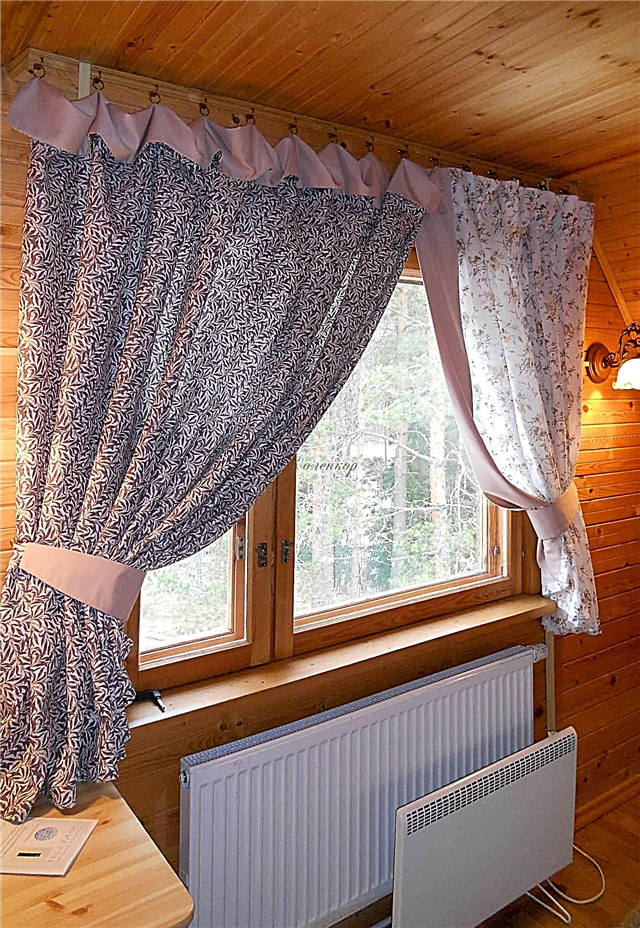
Which tulle is better to choose for rooms for various purposes?
When choosing tulle curtains, the functional purpose of the room for which they are intended is taken into account:
- For bedrooms, living rooms, halls, most often choose long curtains to the floor. In the bedroom for a single-layer curtains use thick muslin. You can choose a delicate translucent material, and provide light protection with a roller or Roman curtain with a dense canvas. In the hall or living room, expensive presentable curtains are needed - a veil with lace inserts, organza, kisei, lace fabric, models with gold and silver patterns.
- In kitchens, short curtains are usually hung up to the windowsill. For this room, practical options are chosen that are easy to clean and can withstand frequent machine washings. Therefore, materials from synthetic and mixed fibers are purchased in the kitchen. The color is often bright, floral pattern, in a cage or strip.
- For the children's room in which the small child lives, usually short models are chosen so that the baby cannot break the curtains or get entangled in them. Colors are vibrant but not annoying. Drawing - floral, geometric, children's.
Before choosing a tulle for window decoration, evaluate the size and architectural features of the room, interior design, lighting intensity on sunny days, the color of furniture and other textiles. Properly selected tulle curtains will refresh and decorate the room, correct the imperfections of the room, and create a cozy and pleasant atmosphere.
Fundamental rules
As in any important business, when choosing curtains, you need to follow some principles. Their observance will help to avoid common mistakes and to get a really high-quality product that will last you for many years.

Three-layer curtains - classic sophistication
- Designers recommend choosing curtains to match the color of furniture, rather than wallpaper. This advice is due to the fact that, as a rule, people change wallpaper more often than furniture, so after repair there is a need to purchase new curtains.

Transparent chiffon curtains add a touch of romance to the interior
- The texture of the fabric should correspond to the drawings and ornaments applied to other elements of the interior. Here you should be extremely careful not to overdo it with the number of patterns in the room. Plain curtains are a universal option, as they perfectly complement any style and will not look elaborate. If you still prefer products with a pattern, choose them very carefully, given the design of furniture and carpets.

Curtains in rich plum-cherry tones harmoniously look in the living room with pastel wallpaper
- Give preference to unusual designs. They will help transform the room and give it a twist. For example, a tulle in a children's room for a girl can be decorated with bright interceptions made in the form of bows, butterflies or hearts. In turn, the curtains themselves may contain images of the baby's favorite fairy-tale characters. We are sure that such a design decision will certainly please the child and will contribute to creative development.

Bright large pattern in the style of Provence - a trend of recent years
- Curtains should be practical. In other words, when choosing a material, attention should be paid to the ease of use and maintenance. Give preference to fabrics that have been treated with special dirt-repellent and fire fighting compounds. In addition, the product must be washable both hand and machine. For example, velvet curtains are difficult to clean at home, so you have to go to dry cleaning, which will entail additional financial costs. Recently, curtains containing natural and synthetic fibers have become increasingly popular, as they combine the advantages of both types: they are practical and have an excellent appearance. Before choosing tulle and curtains, ask your consultant what fabric they are sewn from, find out about its properties and recommendations for care.

The overall pattern on the curtains and tulle will emphasize the unity of style
- Pay particular attention to the selection of material density. Residents of the first floors, experts recommend paying attention to dense fabrics with lining. They will protect the room from sunlight and prying eyes of passers-by. If the room is quite dark, it is better to install curtains made of translucent fabrics that transmit light well and visually increase the space.

In dark rooms you can use openwork curtains - they transmit sunlight well
- Consider the purpose of the room. This is perhaps one of the most important factors. In the bedroom, you should create an atmosphere of peace and security with the help of dense curtains, so that nothing could interfere with relaxation, and the nursery should be dominated by bright colors and colorful drawings that develop the imagination of the crumbs. A short tulle will be the best choice for the kitchen, as long curtains take up too much space and get very dirty. In addition, due to the high risk of fire, it is forbidden to place them near the stove.

Laconic curtains in bright colors will visually increase the space
- In small rooms it is better to install compact designs. Luxurious curtains with lambrequins and many decorative elements are well suited for spacious bedrooms and living rooms. If placed in a small room, they will not only take up a lot of space, but also visually narrow the space. Give preference to concise curtains, complementing them with neat pickups.

Emphasis on bright curtains with a simple geometric pattern - a profitable idea for a bedroom in a minimalist style
- Before you go to the store, make all necessary measurements. Please note that if there is a radiator or battery under the window opening, in accordance with sanitary standards, the curtain should not close them. Otherwise, the fabric will prevent complete heat transfer, and it will take longer to warm the room.

Plain cream organza tulle adds warmth and coziness to the room
- In case you need to visually expand the room, use curtains with a horizontal print, and strict vertical lines will help to make low ceilings higher. Owners of spacious living rooms are often faced with the fact that because of the large windows the room seems uncomfortable. In the photo you can see how a beautiful tulle for the hall, complemented by lambrequins and luxurious drapery, makes the hall refined and comfortable.
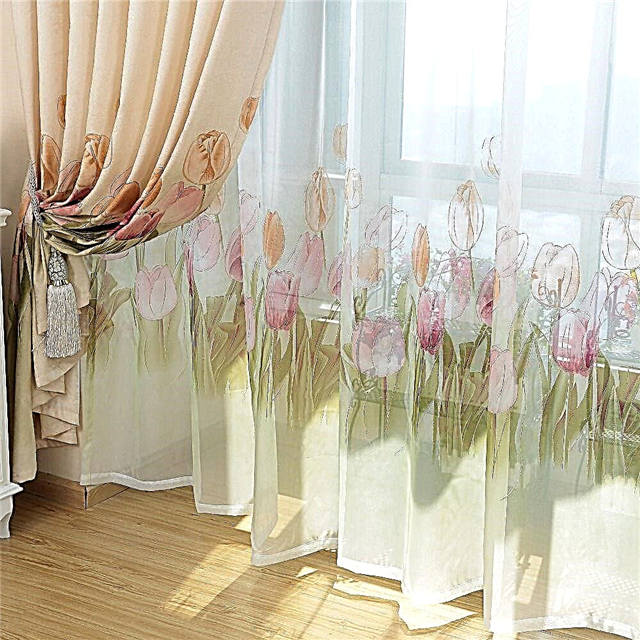
Refined drapery will help the hostess to make a spacious living room more comfortable
- Large window openings are best equipped with two fabric canvases. It will give you

With the help of curtains, you can decorate not only windows, but also doorways
Now that we have covered the basic rules for choosing curtains, you should familiarize yourself with the most popular types for each room.
Kitchen
This room is characterized by a specific microclimate, therefore, the requirements for the material from which the curtains are made are high. The fabric must be resistant to moisture, not absorb odors, have dirt-repellent properties. Give preference to curtains that have been treated with special compounds to prevent them from burning out and igniting.
Attention! As for the views, the installation of Roman or roller blinds would be an excellent solution. They do not require special care, easy to clean, do not take up much space.
They are a holistic canvas, carefully assembled at the top of the window opening. This way they will not bother you while cooking. In addition, a wide range of colors and textures will allow you to purchase the right product for any style. See for yourself by viewing photos of tulle for the kitchen in the interior and photos of new products relevant in 2017.

The basic principle in the design of the kitchen is simplicity and functionality.
Children

Bright curtains in the children's room develop the imagination of the child
Choosing curtains in the baby's room, one should be guided by his age, temperament, gender and preferences. The nursery is a special place where the child spends most of his time, so special attention should be paid to its arrangement.
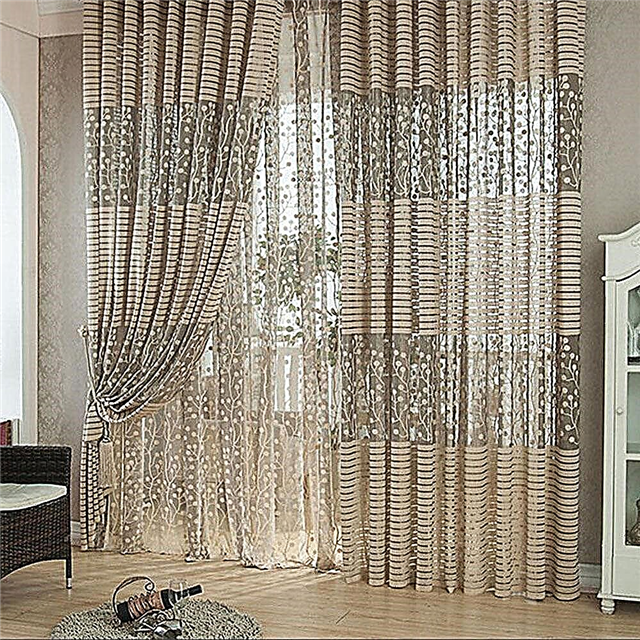
Graceful translucent curtains are suitable for the room of a young lady
Important! Any material can be used for the manufacture of curtains, but it is better to give preference to natural fabrics, as they do not cause allergies.

Satin curtains with guipure accents - sophisticated and respectable
Do not forget that children love active games and often use decorative elements in them. Curtains should not contain sharp parts or small parts that can be swallowed.

Chintz curtains with a small floral ornament will create a good mood for the baby
The color scheme and design must be selected in accordance with the general style of the room. The temperament of the child plays an important role: for choleric and sanguine people it is recommended to choose curtains of calm shades, while phlegmatic and melancholic people will better use bright curtains. Use original pick-ups or magnets as decorations. Tulle in the children's room for the boy can be supplemented with a colorful lambrequin with the image of cars or airplanes.

Soft pink shades - a win-win option for decorating the room of a little princess
Living room
The hall is the central room in the house. It hosts guests, gathers with the whole family to watch their favorite show and arrange celebrations. That is why a set of curtains and tulle for the living room must be chosen very carefully.
Attention! Small rooms are best decorated in light colors using translucent airy fabrics, and dense curtains of saturated colors will help transform a large room.
As for the view, it all depends on the interior design. Classical style and baroque suggest the presence of a large number of shuttlecocks and voluminous draperies. When sewing, as a rule, dense expensive fabrics are used: velvet, brocade and jacquard. Minimalism is characterized by laconicism, so Roman, rolled or filament curtains are perfect. The main thing is that all interior elements are harmoniously combined with each other.

Contrast of white and black - design classic
Bedroom

Bright print is always optimistic
Maximum comfort is the main requirement in the design of the bedroom. This room is designed for relaxation, so the curtains should be quite dense. We recommend that you pay attention to materials called "blackout": they do not let in sunlight and completely close the window from prying eyes. As a rule, they are treated with a special composition that prevents burnout, so they will last you for many years. If a set of curtains and curtains seems too simple for you, complement it with decorative elements. An excellent solution for the bedroom is a tulle with a lambrequin, the photo of which is presented below. You can also use unusual pickups and fringe. The color scheme should have a calming effect, so discard curtains that are too bright. Prefer light pastel or saturated matte shades. Cotton, linen and velvet are the best materials for decorating the bedroom, as they are environmentally friendly and do not cause allergies. Note that natural fabrics need careful care, so more and more people prefer materials from a mixture of natural and synthetic fibers to them.
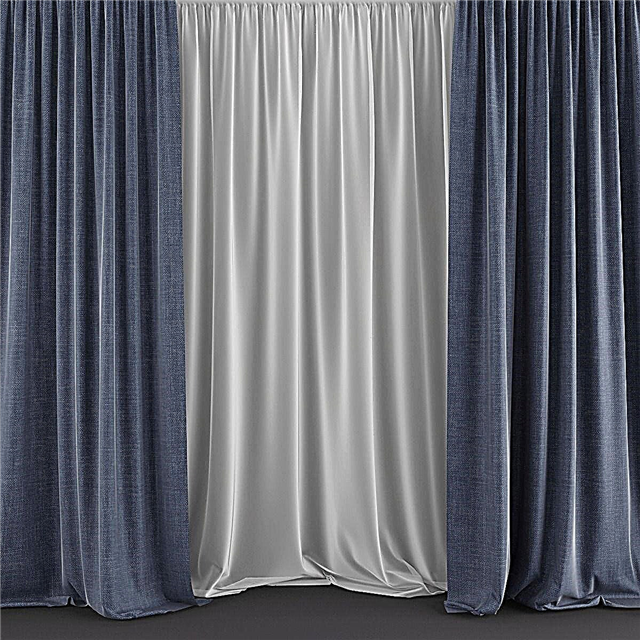
The combination of natural fabrics and colors for the bedroom is of particular importance.
To summarize
Curtains play an important role in the design of the room. With their help, you can not only refresh the interior, but also change the visual perception of the room: make it wider or higher. Before choosing a tulle and curtains, you need to familiarize yourself with the recommendations of designers and take measurements of the window opening.
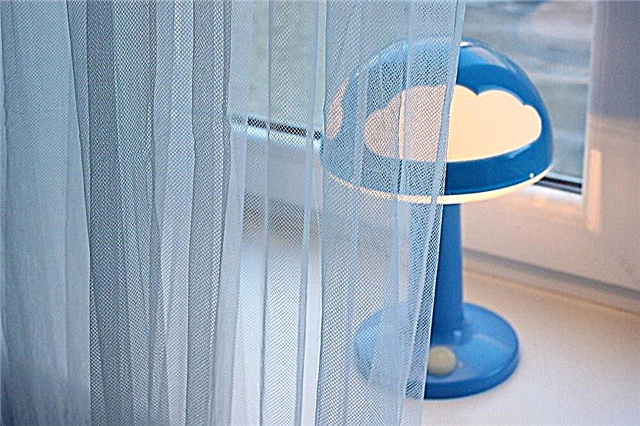
Ideal if the curtains are combined with other decor elements and accessories
Be sure to consider the size, style and purpose of the room, as these factors are key when buying.
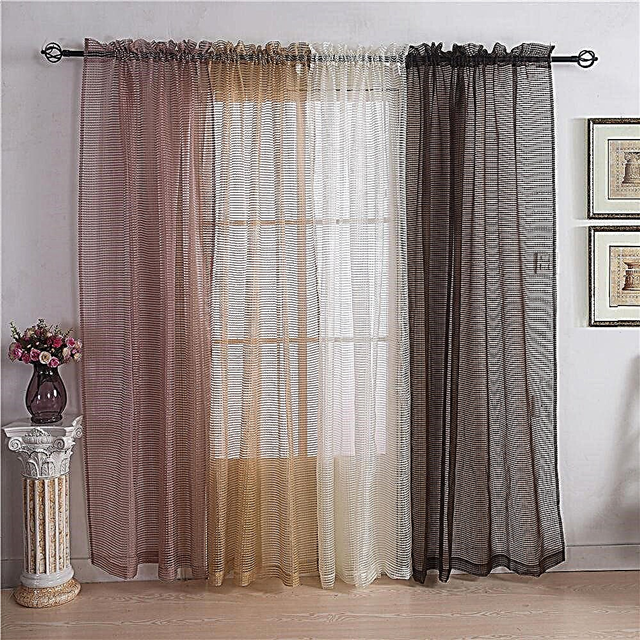
Don't be afraid to experiment with colors.
Curtains should be functional, practical, and also have an aesthetic appearance. Taking into account all of the above requirements, you can definitely get a quality product.

Original captures on the curtains - and the interior takes on a new sound
Types and features of fabrics for tulle.
Tulle can be matte and transparent, woven from thin threads and mesh, can be embroidered or decorated with lace. When choosing a tulle for our windows - first of all, we will analyze what kind of fabric is most often taken for sewing it.
If we talk about which fabrics are used for sewing tulle - most often it is:
- Organza - a fabric made of polyester or silk threads, smooth and transparent, with a strong thread, airy and weightless. Organza does not allow air to pass through, although it is easy to take sunlight, it does not accumulate dust and dries quickly, therefore, it is perfect for allergy sufferers.
- Mesh - fabric, also often used for sewing tulle and is characterized by a mesh structure. It perfectly transmits air and light, is easily erased - it can be used as an independent element of decor, or combined with curtains. It is susceptible to dust and therefore it should not be hung in a room where allergy sufferers live.
- Veil - translucent and thin, made of silk or wool, cotton threads. It is marked by durability of service and perfectly transmits air flow and light, does not accumulate dust in itself.
- Kiseya is a light and airy canvas created from silk or cotton threads, linen fibers, although today synthetic materials are increasingly used.
- Muslin - with its help you can create a special style in the room. Muslin is marked with a special type of weaving, does not let air in, is easy to care for, does not fade in the sun.
Hall - attention to the window.
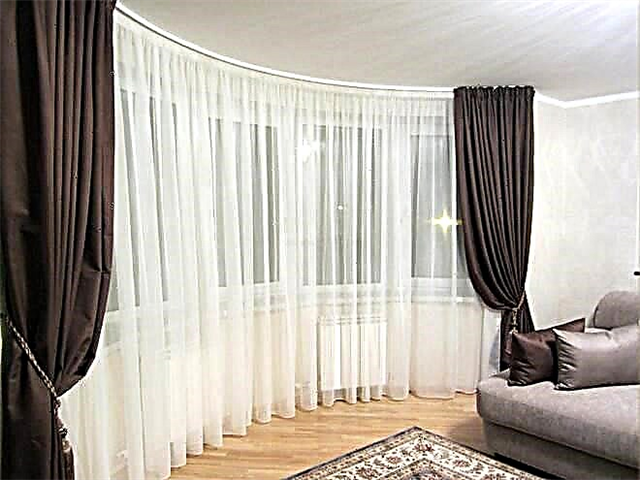
Speaking about the living room, in which luxury should be the main emphasis - it is important to choose a transparent tulle canvas for window decor, decorated with embroidery, silver or gold glitter, complex patterns. But the furniture, designed in the classical style, perfectly emphasizes the plain color of the tulle, without unnecessary folds.
What to consider?
Before choosing a tulle in the kitchen or hall, it is worth determining what function they should perform, and the room itself, for which they are selected, also plays an important role. What is it worth determining for yourself before choosing this or that tulle? These items are:
- They use tulle as a decoration for a window or they carry a certain functional load.
- Consider the size of the window, its shape, as well as the general stylistic design of the interior.
- Practicality and ease of use, for example, on the sunny side, the tulle will burn out faster than on the side of the apartment where less light enters the window. Ease of washing and ironing should also not be discounted.
According to the style of the interior - choose the best.
What should I look for when choosing a tulle, choosing it for a certain interior? After you have decided on the fabric for tulle - it is worth taking a closer look at your own interior, in which it is selected and will organically fit. If you understand the features of each material - this will allow you to properly decorate the window. If you want to see a lot of folds and odds, the use of lambrequins - the tulle should have a smooth surface of its canvas. The choice in this case can fall on the organza and pliable veil.
Regarding the color scheme - it all depends on the general situation, however, there is a rule to choose the tulle for the color of the walls.But the present is such that many modern designers recommend choosing a print tulle, making a bright accent on the window. If you want the tulle to please the eye for a long time - opt for green and orange tones.
If you want to lay a tulle with draperies - you should buy a section of the canvas based on the length of the cornice multiplied by 3 for a dense canvas, and if the fabric is light and airy - you will have to buy 5 times more. And now let's go directly to the interior itself.
- If the room is designed in the style of minimalism, simplicity and the absence of excessive pretentiousness are also required from the tulle. In this case, it is optimal to focus on the fabric texture itself.
- For the classic interior and the room, designed in the Baroque style - stylists recommend focusing on the use of frills and draperies. And it is organza or muslin, muslin, suitable for window decoration as well as possible.
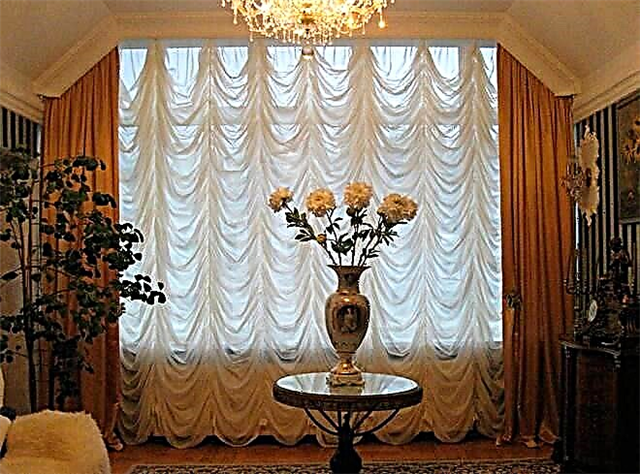
Lighting and windows
The illumination of the room is also an important criterion when choosing a tulle, as is the size of the window opening itself. If the windows overlook the south or south-west - the room will be brightly lit, and the curtain will play the role of such a protective screen that scatters the excess light. For such windows, you can make a choice in favor of bright tulles, as an option - use a custom combination, for example, sewing it from several multi-colored canvases.

When the windows face north, less light enters the room and therefore, in this case, the choice should fall on the light colors of the canvas. You can use a light canvas as the main window decor, or by applying a more non-standard solution - hang the curtains in place of the tulle, and put it in the foreground. So the window, as it were, goes deeper.
If the window is small - you should not choose the dark colors of the tulle or choose a dense fabric that will make the window opening even smaller. It is better to give preference to light tones and airy, weightless fabrics that easily transmit light. It’s easier with large windows - it can be decorated with tulle of any color without restriction, add folds and draperies, use lambrequins. The main thing is to combine them with the interior and decor.
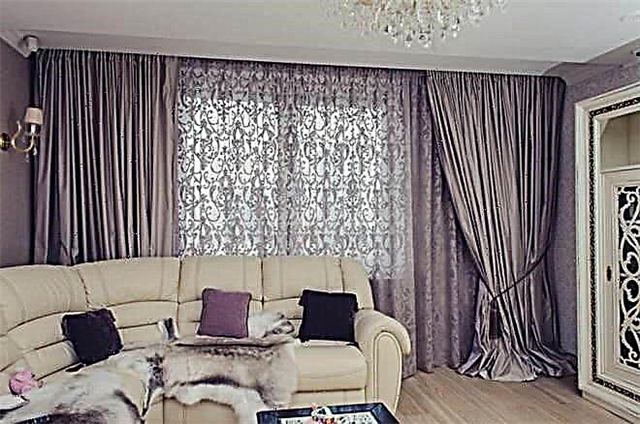
Properly selected decor for windows is the key to the successful design of the entire room. If you take into account our advice - you will make the right choice of tulle, succinctly complementing and completing the entire design, interior indoors.
What it is?
It is difficult to imagine a person who does not know what a tulle is. Everyone associates it with a translucent lightweight canvas made from thin threads of cotton, polyester, silk, etc.
The name of this fabric first appeared in France in the city of Tulle. Initially, it was supposed to be designed so that on one side everything was perfectly visible, while on the other hand only common features could be distinguished. Weavers of the city of Tulle were able to fulfill this requirement in a short time.
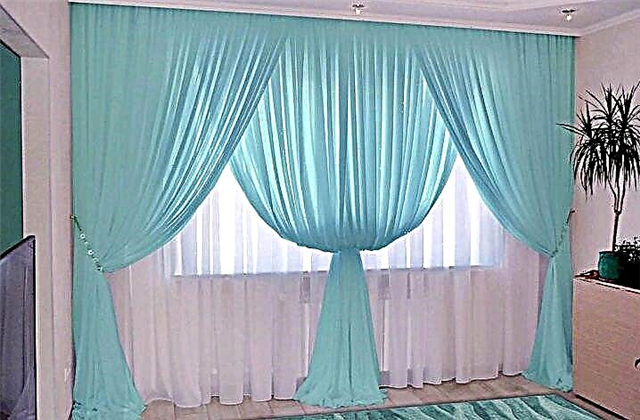
Since the 19th century, tulle fabric has become quite famous, which made it possible to use it to decorate rooms and even to sew clothes.
Currently, tulle is produced using special machines, whereas in past centuries, craftsmen worked on its creation manually. The fabric itself is made of cotton or silk threads. For each type of product, different machines and threads are used.
To get a high-quality and beautiful tulle, it is necessary that it goes through several stages of production: preparation of threads, creation of linen and decoration.

Tulle fabrics can be divided into several types. Each of them has unique properties and characteristics that other tissues do not have.
Organza
Organza – it is a thin, airy and transparent fabric consisting of natural material (silk) and synthetic fibers. The role of synthetics can be polyester or viscose, but most often they still prefer the first option.


To make organza, you need to spend a lot of time and energy, because the technology itself is quite difficult and requires several sessions of special processing of fabric. For these reasons, the cost of fabric is quite high, but it fully justifies itself. High quality and decorative properties make organza in demand among all segments of the population.
The lightness and transparency of the material does not affect its elasticity and strength. Such curtains are durable and have a long service life.
Modern production is aimed at producing a wide variety of organza. So, it can be monochromatic, patterned, matte, shiny, colored, with a pattern, etc. Recently, a chameleon fabric has appeared that is able to change its color at different angles and under different lighting conditions.
The peculiarity of organza is its transparency and lightness, as well as the possibility of combining it with many curtain paintings. It is resistant to dust, therefore does not need frequent washing and does not affect the health of residents. And even the constant presence of material in the sun does not affect its brightness and appearance.
Despite the mass of positive qualities, organza still has some disadvantages. For example, if puffs or other defects appear on it, then it will be impossible to fix them.
For this reason, you should not purchase this type of tulle for a home with small children or playful pets.

Veil
The veil is a translucent canvas with a matte surface that has smoothness. The dense structure of the veil is able to hide small flaws in the repair of a room, for example, made during the decoration of walls or window openings. It will also help to hide an unflattering view from the window from the eyes.
Usually a veil is used to darken a room. This is especially important for those rooms that are on the sunny side. You can use it as an independent window decoration without adding thick curtains.
The veil is soft and supple, so it lends itself well to processing. It can be formed by any available method of drapery curtains.
If we talk about the cons of the veil, we can note its tendency to electrify. For this reason, the fabric easily collects dust and quickly gets dirty.
Washing stains on such a cloth will be a real problem, so it is not suitable for the design of the kitchen window.
Another drawback of the veil is its quick burnout. Long exposure to the sun will cause the fabric to lose its decorative properties. First, the shine will disappear, and then the pattern will fade.
Tulle Net
Tulle netting has become increasingly popular recently due to its lightness and transparency. The mesh can consist of large or small loops that can be woven from natural or synthetic yarns. Usually mesh tulle is used as a complement to window design and plays a supporting role. In exceptional cases, it is used as an independent design.
The grid can have any color and pattern. It can also be decorated with lace, sequins and beads, which allows you to hang it even in the living room. The only drawback of the mesh is its ability to collect dust. But this applies only to the microgrid - large cells pass air better and are not so prone to contamination.
Gas is the interweaving of warp threads with weft threads in such a way that they do not become dense and form a space between themselves. This method of weaving allows you to get a delicate and translucent fabric.
Initially, the gas web was created from silk threads. It had a plain or patterned surface with or without embroidery. Today, viscose and polyester are used to make gas tulle, which significantly saves the buyers budget.
There are several subspecies of gas: gas-rice, gas-marabou and gas-illusion. All of them differ in the technique of weaving and the thickness of the threads. In addition to the two main types of tulle, 3D photo curtains can also be attributed to them. Using special technology, a drawing is applied to the canvas, which is distinguished by its realism. Photo curtain is able to hide the imperfections of the window and the area around it due to the huge image.
The shape of the curtain also differs depending on its purpose. Long straight curtains are usually used to decorate the hall windows, and the tulle arch is traditionally hung in the kitchen. By the method of suspension, it is possible to distinguish curtains that are mounted on rings, on loops or on grommets.
Eyelets are ideal for a room from which there is access to a loggia or balcony. They are easy to push apart, after which they quickly return to their original position.
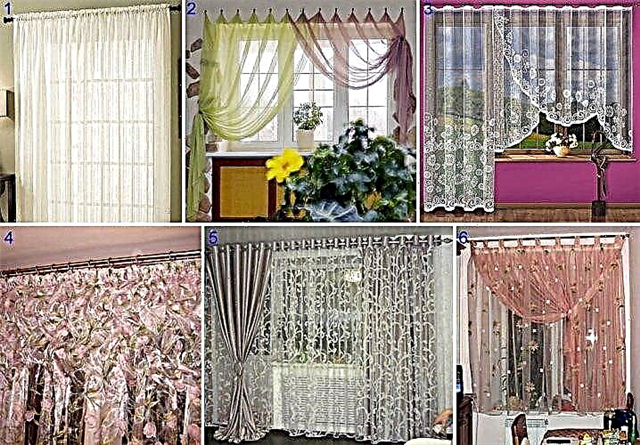
Fashion Design Trends
The variety of shapes and colors of tulle curtains allows you to decorate any interior with them. If the room does not have a certain style, then a curtain of any color can decorate it. Of course, the white color will never lose its relevance, so it can be combined with any decoration and furniture.
If the windows in the living room have complex elements, then a veil is suitable for them. It can be used as the main material, and can consist of several elements. A long pleated tulle veil gives the room a luxurious feel.
A beautiful curtain with guipure inserts is necessary to emphasize the sophistication of the living room.


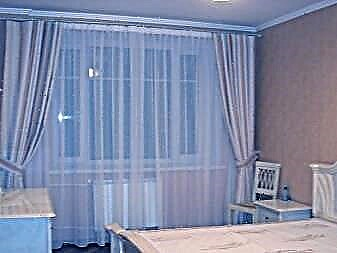

The Art Nouveau style will be emphasized by a dense textured curtain, while Country will be decorated with light cotton tulle.


If the room is decorated in the Provence style, then it will complement the French tulle net.


But for the Classics, the ideal solution would be a tulle with a lambrequin. It can have the most diverse forms: waves, a semicircle, folds, peroxides, etc. The main thing to consider is that if the space has large dimensions, then the lambrequin can have several complex elements.


To smooth a bright and rich interior, you need to use light tulle curtains. It can be shades of beige, white and pink. The item can be decorated with patterns or discreet ornaments to add zest to light curtains. In recent years, stripes or with large flowers at the bottom of the canvas began to go out of fashion.
But phototul, on the contrary, is only welcome. But it can only be used in modern interiors.


Light mesh curtains are now in fashion, which are hung over heavy curtains. It is important that all elements are designed in the same color scheme, differ by only one or two tones. Moreover, the length of the paintings can be such as to reach the floor or lie down a little on the floor.
Fabrics
Initially, tulle webs were made only from natural materials, now artificial fibers are also used.
Previously, all products were created manually. For this, the craftsmen used cotton and silk threads. Silk is an expensive material, so not all buyers can afford it. For this reason, modern tulle can consist of polyester and polyamide fibers, and sometimes polypropylene, polyamide and polyester threads.
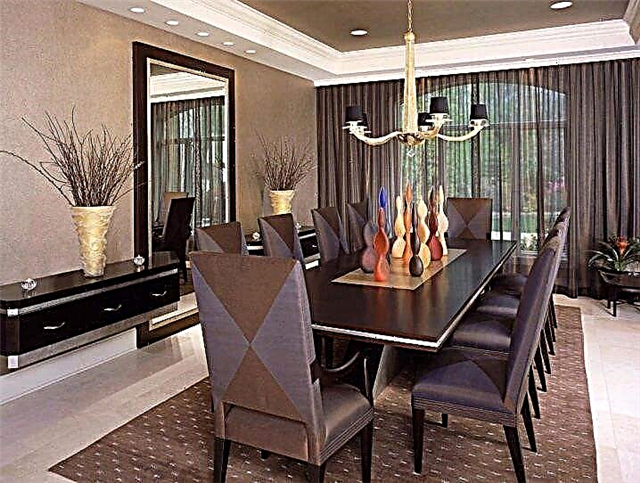
Now tulle fabric has a democratic value, without losing its unique properties:
- The most popular among buyers nylon curtain it looks like silk in appearance. It has a soft structure, transparency and lightness. But kapron is much stronger than silk, and also resistant to dust collection, fading in the sun and loss of shape. It does not need to be washed - you can simply rinse it by hand, shake it off the water and immediately hang it on the curtain.


- The most expensive is considered jacquard tulle, especially if natural materials are used to create it. But you can find a more affordable canvas, consisting of polyester and polypropylene.


- Tulle fabric known for two centuries. It is an airy and weightless fabric made of nylon threads in a net weave.
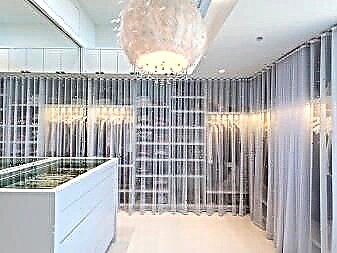

- Does not lose its relevance and linen tulle. True, in its pure form, it does not have shape stability, so modern factories produce linen fabric using lavsan and silk threads. This combination allows you to add shine and elasticity to the fabric.


- Openwork tulle made of synthetic fibers is increasingly used to decorate windows. The lacy texture of the canvas can add sophistication and a sense of luxury to even a modest room.
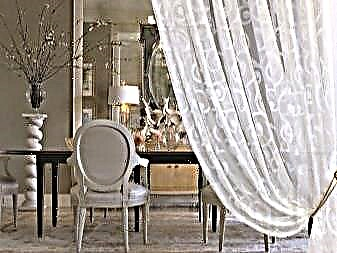
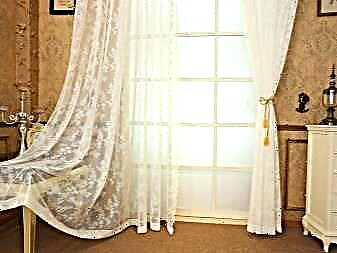
Color schemes
Modern tulle can have any color and texture, which allows you to choose the best option to complement the interior:
- The most common is white tulle with patterns or lace. It is used in cases where the room does not have a certain style or the entire space is made in bright colors. White curtains allow you to let in maximum sunlight.
- But black curtain used with extreme caution and in exceptional cases. After all, black is capable of absorbing light, and therefore is suitable for very bright rooms. The combination of black and light curtains will minimize the negative effects of black, which will play into the hands of the visual perception of space.


